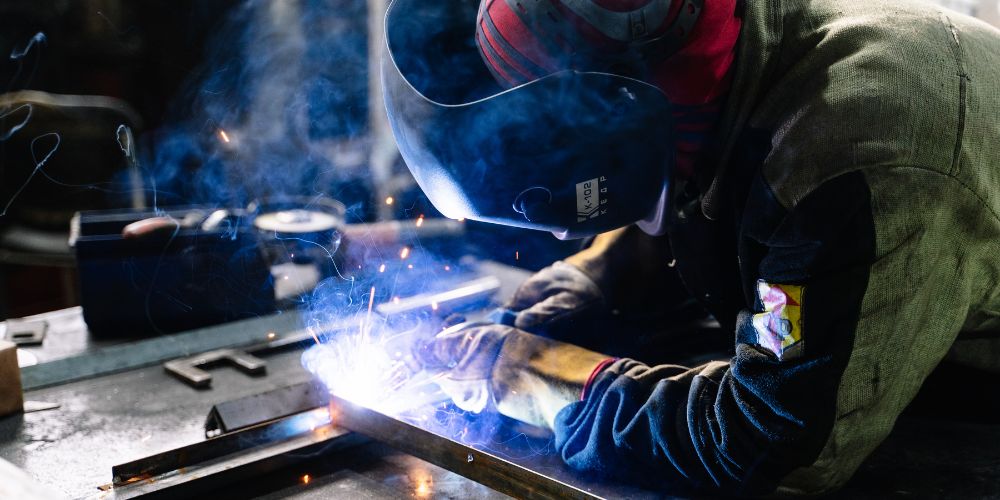
Looking for the best welding gloves? Confused between thousands of options? Don’t worry we are here to save your day. Welding gloves selection depends on some factors. A welding glove can be considered the right choice for you after it meets your unique needs. This blog will explore some tips to help you to find the best welding gloves for you.
Types of Welding Gloves
Welding gloves are made for the safety of welders. As welders are engaged in the welding process their hands are at the most risk. Welding gloves protect your hands from sparks and molten metal. Thus selecting the right pair according to the nature of your work is crucial. Here are some different types of welding, and each of them requires a different type of protection.
MIG Welding Gloves
MIG(Metal Inert Gas) welding is known as the most dangerous welding method as it uses electricity to fuse two metals. Thus this type of welding also exerts a massive amount of heat and spatter. To protect welders' hands from these sparks top-grain cowhide, deerskin or goatskin gloves are most suitable. These gloves are typically made of thick, heat-resistant leather and provide excellent protection against sparks and heat.
TIG Welding Gloves
TIG(Tungsten Inert Gas) welding is considered less harmful than MIG since the former one produces less spark and heat than the latter one. Nevertheless, TIG welding gloves also include some extra padding on the fingers and outside of the glove for extra protection. TIG welding gloves are thinner and more flexible, allowing greater dexterity. They are perfect for intricate welding work. As TIG welding includes delicate metal welding the TIG welding gloves are made through simple goatskin. You can also check out Strongarm’s removable finger gloves for TIG welding. Stick Welding Gloves. Stick welding produces the most sparks and spatters so having a protective pair of gloves is essential during this process. For stick welding, consider using gloves made from materials such as leather split-grain, elk skin, pigskin, or goatskin. You don't necessarily need highly flexible gloves for this type of welding; instead, the thickness of the gloves is the key factor. This is because stick welding generates a significant amount of spatter and heat, requiring extra protection. For stick welding, you'll need gloves that offer both heat resistance and durability. Stick welding gloves are usually made of heavy-duty leather and provide optimal protection against burns and sparks. The only material that is suitable for this purpose is Cowhide Leather. You can also choose pigskin, goatskin, and elk skin material for stick welding gloves.
Welding Glove Materials
Once you are aware of your requirement, it would be easy to choose the material accordingly. Whether you are looking for a pair of gloves for MIG welding or stick welding always check the material of the gloves. If you're new to the industry and find it challenging to select the right material, don't worry. Here are various skin types that are well-suited to your needs.
Varieties of Gloves by Skin Material
Cowhide Cowhide gloves are tough and heat-resistant, making them suitable for high-temperature welding. These types of gloves provide an effective shield against sparks, molten metal, and other welding hazards.
Pigskin
Pigskin gloves are lightweight and comfortable, making them ideal for TIG welding and delicate work. Such gloves are highly flexible and offer excellent dexterity. Pigskin is naturally resistant to oil and water, which can be advantageous in certain welding environments where these substances may be present. Kevlar Kevlar gloves are a modern marvel, known for their exceptional heat resistance. Welding gloves with Kevlar stitching provide added strength and protection, ensuring longevity.
ELK Skin
Elk skin is known for its softness, however it still provides sufficient protection against sparks and moderate heat. They also offer good dexterity, allowing welders to maintain precision in their work.
Deerskin
Deerskin is renowned for its remarkable softness. While deerskin may not provide the same level of heat resistance as cowhide, it still offers decent protection against sparks and splatters.
Leather Grain
Full-grain leather welding gloves are a top-tier choice among welders. These gloves are extremely durable and protect welders from the extreme temperatures generated during welding processes.
Split
Split leather is known for its durability and cost-effectiveness. Split leather is often derived from the lower layers of animal hide. While it is not as durable as full-grain leather, split leather still offers respectable durability.
Factors to Consider While Buying A Welding Glove
Here are some of the factors that will help you get the most durable welding gloves.
Heat Resistance
Heat resistance is a critical factor to consider when buying welding gloves because it directly impacts the safety and comfort of welders during your work. Welding involves extremely high temperatures, often exceeding thousands of degrees Fahrenheit and without heat-resistant gloves, your skin will experience severe damage.
Fit and Comfortable
To maximize your productivity, comfort while working is essential. Gloves that fit well and provide comfort enable more effective work. They should offer a snug fit without feeling too constricting. Ultimately, comfortable welding gloves significantly enhance your overall welding experience.
Dexterity
Consider the level of dexterity required for your welding tasks. Precision work, such as TIG welding, demands gloves that allow for intricate movements. Consider the level of dexterity needed for your welding tasks. For example, TIG welding, requires more precise movements than other welding processes.
Durability
Invest in gloves that can withstand the wear and tear of your specific welding work. Heavy-duty gloves are essential for long-term use. Durability ensures your gloves last longer. If you are investing in a working gear then look for a durable one to ensure productivity and maximum safety. Check out Strongarm’s durable welding gloves for more protective gears.
Coverage
The coverage area of the welding gloves is also of extreme importance. . Opt for the welding gloves that cover up the wrist area along with the hand for maximum protection.
Considerations in Welding Glove Selection
Before selecting your welding glove, it's important to consider several key factors. First, check for ANSI/ISEA ratings, which indicate that the gloves meet the safety standards set by the American National Standards Institute (ANSI) and the International Safety Equipment Association (ISEA). These ratings ensure that the gloves have been rigorously tested for specific safety criteria. Furthermore, always inspect your welding gloves for any signs of damage before each use, including holes or other visible issues. If you find any damage, it's crucial to replace the gloves immediately to maintain your safety while working. It's a good practice to inspect the gloves as soon as you receive them to ensure they are in pristine condition. Your diligence in checking for safety ratings and inspecting for damage will help protect you during your welding tasks.
Tips for Maintaining Your Welding Gloves
Your welding gloves are an investment in your safety, so taking care of them is crucial. Here are valuable tips to help you maintain your gloves, extending their lifespan and ensuring they provide you with optimal protection.
Clean Regularly
After each use, clean your welding gloves thoroughly. Use a soft brush or cloth to gently remove dirt elements, ensuring your gloves remain in good condition for a longer time. Wiping off dirt and any metal particles not only keeps them hygienic but also prevents these particles from scratching or damaging the gloves.
Avoid Moisture
Leather, a common material for welding gloves, can be significantly affected by moisture. Store your gloves in a dry place away from direct sunlight and dampness.
Recondition Leather
Leather can become stiff or dry over time thus it is essential to keep it moist. Applying conditioner periodically, as per the manufacturer's recommendations, can extend the lifespan of your gloves and maintain their comfort and functionality.
Conclusion
Safety should always be your top priority when it comes to welding, and these gloves are essential lifesavers, guarding against potential damages and burns. Selecting the right fit for your welding gloves is of utmost importance. The choice of welding gloves depends on several critical factors, so it's crucial to carefully consider these factors before purchasing a pair of welding gloves. Your well-being and protection are at the forefront of this decision.






